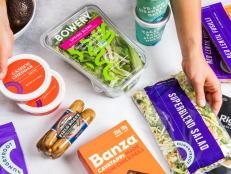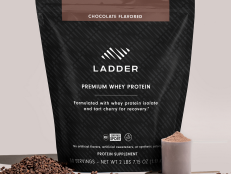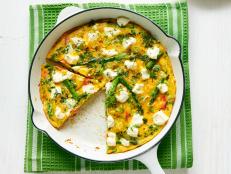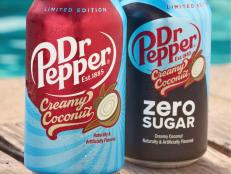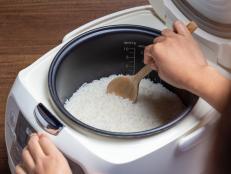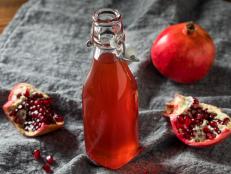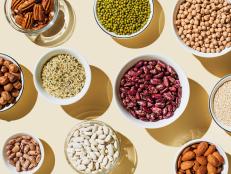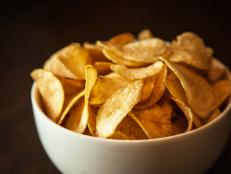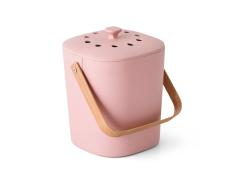Smart Shopping Guide for Healthy Meals
Shopping for your week's groceries is always a puzzle. How do you get everything you need in one shot and avoid midweek runs for forgotten items? Here are some tips from the Food Network Kitchens.

By incorporating your family's likes and dislikes, sticking to a budget and using your store as a map, you will be on your way to a successful supermarket sweep.
This guide outlines weekly shopping strategies for when you want to eat healthy. One great way to put a healthy spin on your cart is to concentrate on the foods around the perimeter of the store. With refrigeration, ventilation and water access, this is where the fresher foods are kept. The foods in the center aisles are generally more processed, with some exceptions like dry and canned single-ingredient items such as beans, grains or baking supplies.
Try thinking about your grocery cart like the food on your plate. Our nation’s new "plate" calls for 50 percent fruits and vegetables! The rest is divided between proteins and whole grains. Seems like a great way to start filling your cart.

First stop: Head for the produce section. This week, you’re bulking up on fruits and vegetables, which take up a lot of space. Pick six to eight vegetables and another four fruits to bring home with you this week. Use up produce that will spoil quickly, such as leafy greens and thin-skinned berries toward the beginning of the week and rely on your pantry staples and frozen goods toward the end. Root vegetables, like potatoes and carrots, and heartier fruits like apples will hold just fine as the week goes on as well.
- Greens: Buy a variety! There is nothing worse than a boring, limp salad — try arugula, escarole or radicchio for a fresh spin. Buy chard and kale to wilt as a side dish or make them the star of your dinner plate by topping with a poached egg.
- Potatoes: Potatoes get a bad rap because of their carbs, but really, one russet potato contains about 150 calories and lots of potassium. They are an inexpensive and filling vehicle for the addition of more vegetables, like sautéed spinach, and a sprinkling of Parmesan cheese. Sweet potatoes also have a lot going for them.
- Assorted snack veggies: Carrots, celery, cucumber, jicama and bell peppers are all great choices to have on hand. Not only can they be incorporated into meals, but you can also bag them up for a bite on the run.
- Berries: During the summer, stock up on berries when they are cheap and plentiful. Usually a breakfast item, berries can also be tossed into salads and eaten for dessert.
- Apples: Apples are the perfect snack on the run — try them with a little peanut or almond butter. Also, try coring and roasting apples with some cinnamon and brown sugar for a simple, healthful dessert.
Next, take a walk down the protein aisle. Because this week we’re incorporating more fruits and vegetables, your protein list won’t be long. Buy three to four proteins that can be used for both dinner and lunch, with leftovers rolled into new meals.
- Ground meat: Try picking up a package of lean ground chicken or turkey. Make a healthy burger or lightened-up whole-wheat pasta dish. Ground lean proteins offer endless options. Often on sale, buy in bulk and freeze any meat you don’t use up. Store up to three months. (It’s always good to have leftover proteins in your freezer as a backup plan.)
- Pork: With the hysteria around bacon, pork belly and pig product in general, it’s easy to forget that there are cuts of pork that are lean and healthful. Try picking up a package of boneless pork chops or pork tenderloin. Low in fat, pork can be a great alternative to the overused chicken breast.
- Seafood: Fish and shellfish are low in calories and fat, and should be turned to time and time again for healthful eating. Pick up a bag of mussels or clams and steam with white wine and herbs.

Your cart should be filling up at this point, but you have a few more aisles to check out. Next, the frozen food sections.
- Frozen fruits and vegetables: Picked at their peak of freshness, frozen produce is a wonderful solution. Bulk up when items are on sale and keep in your freezer for months. Then pull them out for soups, smoothies and stir-fries.
- Frozen shrimp: Normally we would say that frozen seafood is a big no-no, but frozen shrimp is actually a great solution when you’ve run out of proteins for the week. Defrost the shrimp in your refrigerator the night before you want to use them (worst case, defrost in the microwave) and toss into stir-fries, pasta sauces or a whole-grain salad.
- Sorbet: Do your best to stroll past the ice cream this week, and look for fruit sorbets that will satisfy that craving with fewer calories and less sugar. Fruit bars are also a great substitute for ice cream bars.
Keep walking and pick up a few necessities in the dairy section:
- Eggs: Full of protein, eggs are a go-to for any meal. A great solution once you’ve used your proteins for the week, eggs can be poached and placed over a warm salad, or scrambled and served alongside some roasted vegetables. Hard-boil them and keep them for midafternoon snacks as well.
- Parmesan and feta cheeses: A little dairy never hurt anyone, especially when using a small amount packs such big flavor. Simple, salty toppings for dishes any time of day.
- Nonfat Greek yogurt: A great way to start the day is with a bit of honey, scoop of berries and nonfat Greek yogurt. This thick, creamy alternative to regular yogurt is a power player in light eating. Also, use instead of mayo in dips or creamy salad dressings.
And finally, make sure you grab some:
- Whole grains: Grains like bulgur, farro, quinoa and barley are a fantastic substitute for rice and pasta. Higher in fiber, these grains can be combined with leftover cooked vegetables or proteins for a warm salad lunch or tossed with herbs and reduced-fat feta for a zippy side dish. These whole grains will be integral in a healthy week of eating — kids won’t miss pasta at all.
Grocery shopping is truly an art form, one that takes practice to get just right. Ultimately, you need to choose items you like to eat, so you’re not tempted to pick up takeout or microwave a frozen pizza. Think about how your family eats, their likes and dislikes and walk the market with those needs in mind. With a plan and the aisles of your supermarket as your guide, you’re off to a great week of healthy eating.
Before you head to the store, make sure your pantry is stocked, and check out more smart shopping strategies and recipe ideas from Food Network.























